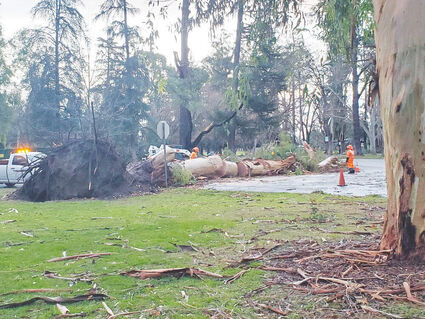Rain and wind like you would not believe hit California
January 25, 2023

Anne Basye
CITY OF TREES LOST A LOT OF THEM – William Land Park is Sacramento's largest city park and two blocks from the writer's mother's home. At least three-dozen trees, like this eucalyptus, came down in the Jan. 6 storm.
In the first three weeks of January, 32 trillion gallons of rain and snow fell on California.
I was there for an awful lot of them.
Usually, when I make my holiday sojourn to Sacramento, I enjoy slightly warmer temperatures and a whole lot more sun than I get in Skagit County in the winter.
Not this year.
Rain began just a few days after I pulled up to my mom's house on Dec. 19. At first, it was refreshing and from what I saw on my drive south, badly needed. But one storm turned into one atmospheric river after another and New Year's Eve brought high winds. Around 8 p.m. we heard an explosion – the first of a thousand drought-stressed trees toppling as 60-mile gusts swept through the region. The power went out shortly after.
The next morning, mature cork oaks, stone pines, eucalyptus and several varieties of fir trees lay on their sides or on top of bleachers and picnic tables in the oldest, shadiest parks in town. Many had fallen across arterials and streets. In neighborhoods, they had blocked streets, crushed cars, damaged roofs and pulled down electrical wires. One unhoused Sacramentan was killed when a tree fell on her tent.
It was a tragedy for a place that calls itself the City of Trees.
Shortly after the gold rush began, a miner planted 12 cottonwood trees near his tent, reports the 1998 paper, "From nature to nurture: The history of Sacramento's urban forest." By the 1930s, proud residents bragged that per capita, Sacramento had more trees than Paris. Today the city's huge urban forestry division maintains about 100,000 public trees, and there are said to be a million trees within the city limits. You can't cut one down, even in your backyard, without a permit.
Rain and wind continued the first week of January. Every night, my mother lay awake worrying that the 70-foot tall redwood next door would crush her house and visiting loved ones. When the wind sounded like a freight train, as it did on Jan. 6, the second high-wind storm, I worried too.
That night, branches from the redwood dropped and the fence, but the tree is still standing. The neighbor's insurance will fix the fence and clean up the mess. And while the southern part of Sacramento County experienced severe flooding from the Mokelumne and Cosumnes rivers, floods don't disturb my mom's sleep.
Like Skagit County, Sacramento sits a few feet above sea level in a river delta. A century and change ago, rain events like this one would cover the Sacramento Valley with so much water, it looked like an inland sea. Now, dams, levees, weirs and the three-mile wide, 40-mile long 16,000-plus acres Yolo Bypass Wildlife Area help keep cities and farmland dry. Land within the Bypass has no permanent structures and is farmed in summer. When the Sacramento, Feather and American rivers rise, the Bypass can divert 500,000 cubic feet of water per second around the main channel of the Sacramento river to where the delta empties into the San Francisco Bay.
Half a million cubic feet of water per second is a lot of water – about four times as much as the 120,000 cubic feet we saw in the Skagit River during the November 2021 flood.

The rainstorms have ended, but tree cleanup continues. The city has its hands full cutting, chipping and mulching trees. The waiting list for private tree services is long.
And people are thinking about the future. Levees in California – and there are about 20,000 miles of them, mostly in the Central Valley – are owned and maintained by a mix of government agencies and private landowners. The Cosumnes River levee that failed and flooded the southern part of Sacramento county is probably a private one. After paying so much attention to drought measures, is it time to focus on flood prevention again – before the "super" storm system predicted by climate change experts arrives?
As for the future of trees, city foresters will be replacing the fallen park and street trees as soon as they can. As well, the Sacramento Tree Foundation has been helping the cities of Sacramento and West Sacramento plant 500,000 new trees by 2045. "Under-canopied" neighborhoods, largely low-income, are the first focus. Which is good. When it is 100 degrees out, shade makes life bearable.
I'm glad the City of Trees wants life to be bearable for all its residents.




Reader Comments(0)